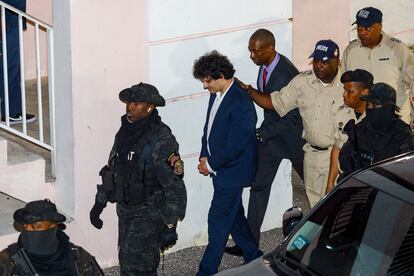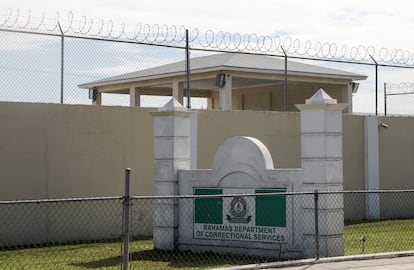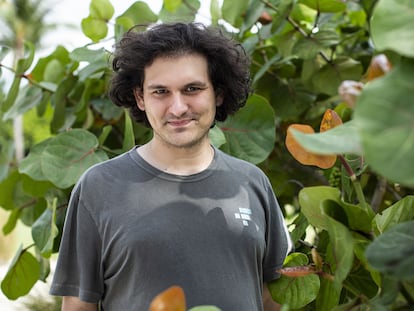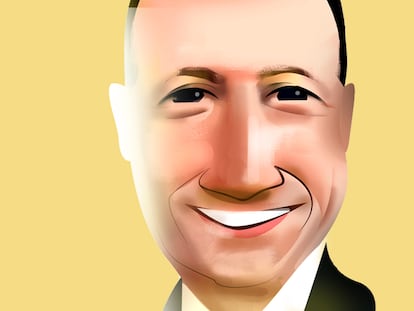From a luxury penthouse to a rat-infested prison: The fall of crypto king Sam Bankman-Fried
Before his arrest, the FTX founder was living a life of excess with his polyamorous friends in the Bahamas – all at the expense of the money of his defrauded clients and investors


A 17 mile-journey separates the exclusive residential complex of Albany from Fox Hill’s mazimum secity prison. They are at opposite ends of New Providence, the most populous island in the Bahamas. And between them, lies a world of difference. The young fallen king of cryptocurrencies, Sam Bankman-Fried, has gone from his luxury penthouse, where he led a life of excess, drugs and polyamory – at the expense of his defrauded FTX clients and investors – to a prison in appalling conditions.
Fox Hill prison – the only penitentiary in the Bahamas – suffers from “overcrowding, poor nutrition, inadequate sanitation and inadequate medical care,” with cells “infested with rats, maggots and insects,” according to the latest State Department report on the Bahamas. Bankman-Fried was denied bail, and he must wait in the prison until he is extradited to the United States, where he is facing eight counts of conspiracy and fraud. If convicted, he could be sentenced to a maximum of 115 years in prison.

Bankman-Fried’s parents, both law professors at Stanford, came to the bail hearing and hugged him goodbye. The 30-year-old also said goodbye to his life of excess, which was financed with $8 billion in funds allegedly embezzled from clients of FTX, the cryptocurrency trading platform he founded. Bankman-Fried and other executives spent hundreds of millions of dollars on luxury homes in the Bahamas. The FTX founder lived in a large penthouse with his twenty-something-year-old friends, who were also executives at the firm. His parents lived in another house on the island, also paid for by the company, which bought dozens of homes for its employees.
Nothing was off limits. The Financial Times reported that after moving the company’s headquarters from Hong Kong to the Bahamas last year, and realizing they could not get Amazon deliveries there, the group contracted a private air transport service to fly over shipments from Miami.
Life in the Bahamas
Bankman-Fried, 30, misled not only investors, lenders and clients. He also tried to fool everyone into thinking he was a frugal person (who drove a Toyota Corolla and dressed in a T-shirt and shorts) and an altruist, who only wanted to earn money so he could donate it to good causes. When talking about his $30 million luxury mansion, he described it as “an apartment” meant for four people that had been converted to fit 10. “It’s nice, even though we’re overcrowded,” he said in an interview with CNBC a little over three months ago, when he was still boasting of his legacy and generosity. Food, massages and other expenses were all paid by the company. Separating work and play was difficult.
Bankman-Fried lived in the penthouse with nine friends he had met either at the Massachusetts Institute of Technology (where he studied Physics) or at the investment firm Jane Street, where he began his professional career and learned quantitative investment methods. His roommates included FTX co-founders Gary Wang (head of technology) and Nishad Singh (director of engineering), as well as Caroline Ellison, the manager of Alameda Research, Bankman-Fried’s private crypto firm, which played a central role in FTX’s collapse.
Ellison, 28, had dated Bankman-Fried, but according to the crypto news site CoinDesk, which broke the news that triggered the collapse of FTX: “all 10 are, or used to be, paired up in romantic relationships with each other.” The group dabbled in polyamory, a consensual form of polygamy in which couples seek multiple romantic or sexual relationships, and are thought to have been in a “polycule,” i.e., a network of interconnected romantic relationships, as described by University of Washington professor Riki Thompson. The Wall Street Journal also reported that romantic relationships between members of the upper echelons of FTX were common.
Caroline Ellison wrote candidly about her “‘foray into poly” on her now-deleted Tumblr account back in February 2020, according to the Daily Mail. “When I first started my foray into poly, I thought of it as a radical break from my trad past,” Ellison allegedly wrote in the Tumblr entry. “But tbh [to be honest] I’ve come to decide the only acceptable style of poly is best characterized as something like ‘imperial Chinese harem.’ None of this non-hierarchical bullshit; everyone should have a ranking of their partners, people should know where they fall on the ranking, and there should be vicious power struggles for the higher ranks.”
When asked about the romantic situation at the penthouse, Bankman-Fried said he was tired of people bringing up the subject. “As a society, in my humble opinion, have spent about enough time this week trying to figure out whether anyone living in Albany was polyamorous.” The FTX founder has since said that he is no longer in a relationship with Ellison. According to some reports, Ellison has been seen in New York, and may be negotiating to collaborate with authorities in their investigations against Bankman-Fried.
Medication
Stimulants, antidepressants and other drugs were also a regular part of life at the Albany penthouse. “Nothing like regular amphetamine use to make you appreciate how dumb a lot of normal, non-medicated human experience is,” Ellison tweeted last year. “Stimulants when you wake up, sleeping pills if you need them when you sleep,” Bankman-Fried tweeted in 2019. The fallen crypto king also said “probably half of all people or more should be taking meds of some kind, because they just make your life a lot better,” in a 2020 podcast, adding that nootropics, or brain-boosting drugs, can be “life-changing.”
But in a recent interview with The New York Times’ Andrew Ross Sorkin at the DealBook summit, he argued that he never saw illegal drugs being used in the office or at parties in his penthouse. He denied throwing wild parties and claimed that they hardly drank alcohol. “When we had parties, we played board games,” he said.
Bankman-Fried said that he was only taking drugs that had been prescribed for him. At the bail hearing, his attorney asked the judge to allow his client to take his medication, which had been removed from him when he was arrested. When Bankman-Fried said that he had to take off his shirt to take the medication, the judge ordered him to leave the room. The FTX founder uses Ensam patches, a powerful antidepressant.
FTX masked its deception behind an elaborately-built front. Before the firm’s collapse, Bankman-Fried spent $135 million sponsoring the NBA team Miami Heat. He also enlisted celebrities such as supermodel Gisele Bündchen, her ex-husband, legendary American football player Tom Brady and basketball star Stephen Curry. He paid for a Superbowl add. And made multimillion-dollar donations to the Democratic and Republican Parties – donations the public prosecution now argue were illegal because they were financed with clients’ money.
At one point, FTX was valued more than Deutsche Bank, with Bankman-Fried’s fortune – on paper – exceeding $25 billion. He received hundreds of millions of dollars in “loans” from the company, also financed by clients. Now he says he has about $100,000 left in the bank. He also has multimillion-dollar debts with the company.
A promising start
Bankman-Fried was a brilliant student. He was born in 1992 on the campus of Stanford University, where his parents worked. As a teen, he showed great skill in mathematics. He had a difficult time in high school and then began studying in MIT, where he fit in with a fraternity that was more interested in playing video games than getting drunk. At MIT, he met Wang, who was already an expert in cryptocurrency. Bankman-Fried interned at the investment firm Jane Street Capital and joined after finishing his studies. He was good at it. While at Jane Street, he met Caroline Ellison.
By that point, he had begun to show an interest in altruism. He thought that instead of working directly with those in need, he would be more effective if he got rich and donated his fortune. He left Jane Street after three years, and started Alameda Research, an investment firm specializing in cryptocurrency. He co-founded the company with Wang, a technology expert who had started working at Google.
The idea was simple, and it worked well: it was based on arbitrage, taking advantage of price differences between markets. Bitcoin was trading much higher in South Korea and Japan than it was in the United States. If he was able to overcome the regulatory obstacles and liquidity problems of crypto assets, he could buy cryptocurrencies in the United States and sell them in Asia for up to 30% more. Easy money.
Alameda was successful. Bankman-Fried’s next step seemed obvious: create his own cryptocurrency trading platform to help large and small investors access the crypto market. He took the plunge in 2019. He founded FTX in Hong Kong, which had more favorable regulation. The exchange platform worked reasonably well; it was well-designed and became a commercial success. However, it lacked internal controls and risk management protocols (payment requests were approved with emojis in an online chat platform).
But FTX was one big lie from the start. There was no transparency and no proper controls. Customer money was being transferred to accounts that were actually controlled by Alameda. The company took out the money as loans, but there were no real guarantees. Funds belonging to FTX, headed by Bankman-Fried, and Alameda, led by Ellison, became one and the same.
While the crypto market went from strength to strength and Alameda continued to earn revenue from its investments, Bankman-Fried was able to fool everyone. But when the market plummeted, it was revealed that Alameda had been using FTT tokens as collateral for the more than $8 billion in cash that it had taken from customers through the line of credit. Bankman-Fried, once described as the “white knight” of crypto, was in fact a villain, according to the charges against him. If convicted, the 30-year-old may spend a lifetime behind bars.
Sign up for our weekly newsletter to get more English-language news coverage from EL PAÍS USA Edition
Tu suscripción se está usando en otro dispositivo
¿Quieres añadir otro usuario a tu suscripción?
Si continúas leyendo en este dispositivo, no se podrá leer en el otro.
FlechaTu suscripción se está usando en otro dispositivo y solo puedes acceder a EL PAÍS desde un dispositivo a la vez.
Si quieres compartir tu cuenta, cambia tu suscripción a la modalidad Premium, así podrás añadir otro usuario. Cada uno accederá con su propia cuenta de email, lo que os permitirá personalizar vuestra experiencia en EL PAÍS.
¿Tienes una suscripción de empresa? Accede aquí para contratar más cuentas.
En el caso de no saber quién está usando tu cuenta, te recomendamos cambiar tu contraseña aquí.
Si decides continuar compartiendo tu cuenta, este mensaje se mostrará en tu dispositivo y en el de la otra persona que está usando tu cuenta de forma indefinida, afectando a tu experiencia de lectura. Puedes consultar aquí los términos y condiciones de la suscripción digital.
More information
Archived In
Últimas noticias
Most viewed
- Sinaloa Cartel war is taking its toll on Los Chapitos
- Oona Chaplin: ‘I told James Cameron that I was living in a treehouse and starting a permaculture project with a friend’
- Reinhard Genzel, Nobel laureate in physics: ‘One-minute videos will never give you the truth’
- Why the price of coffee has skyrocketed: from Brazilian plantations to specialty coffee houses
- Silver prices are going crazy: This is what’s fueling the rally










































